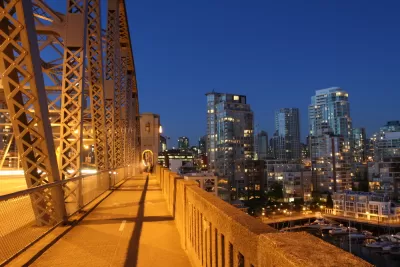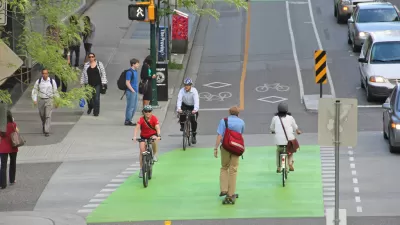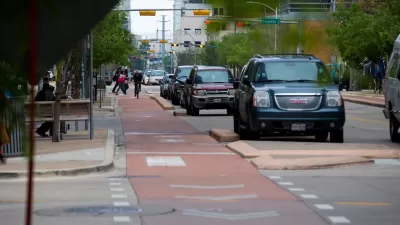Building protected bike lanes in Canada isn't as controversial as it once was. Maybe there's hope for the United States?

The Globe and Mail's editorial board dares to ask if the "war against bike lanes" is finally coming to end in Canada—with people on bikes emerging as the unlikely victor in this battle for public space.
The latest bike lane projects in Vancouver, under construction on Richard and Smithe streets on the city's downtown peninsula, moved forward without attracting controversy, , according to the editorial board—the opposite of bike lane projects in the late 2000s.
Take, for example, the opening of the city's first protected bike lane on the Burrard Bridge:
‘Chaos’ feared, blared one headline. “Doomed to failure,” opined a columnist. All that proved incorrect: The Burrard Bridge bike lane, billed as the busiest in North America, saw 1.4 million rides in 2020, 40 per cent more than its first full year a decade earlier.
The relative peace of the two latest projects in Vancouver tell a story that repeats all over the county, according to the editorial board:
Penticton, in the British Columbia Interior, this summer opened its Lake-to-Lake bike lane; it plans to invest $15-million over the next five years. Sarnia, Ont., is extending its bicycling network. In Halifax, about a third of a planned 57 kilometres of protected bike lanes is complete. It includes Hollis Street through the heart of the city. Montreal last November opened a long north-south route on Saint Denis Street as part of its Réseau express vélo network.
Toronto, spurred by the pandemic, has installed protected lanes across the city. One new segment on Bloor Street East opened in late September. These lanes are billed as temporary, but it would be a short-sighted mistake to reverse course.
What was once a "political flashpoint" and an "ideological signifier" is now "standard-issue" civic infrastructure.
FULL STORY: Is the war against bike lanes finally over?

Planetizen Federal Action Tracker
A weekly monitor of how Trump’s orders and actions are impacting planners and planning in America.

Map: Where Senate Republicans Want to Sell Your Public Lands
For public land advocates, the Senate Republicans’ proposal to sell millions of acres of public land in the West is “the biggest fight of their careers.”

Restaurant Patios Were a Pandemic Win — Why Were They so Hard to Keep?
Social distancing requirements and changes in travel patterns prompted cities to pilot new uses for street and sidewalk space. Then it got complicated.

Platform Pilsner: Vancouver Transit Agency Releases... a Beer?
TransLink will receive a portion of every sale of the four-pack.

Toronto Weighs Cheaper Transit, Parking Hikes for Major Events
Special event rates would take effect during large festivals, sports games and concerts to ‘discourage driving, manage congestion and free up space for transit.”

Berlin to Consider Car-Free Zone Larger Than Manhattan
The area bound by the 22-mile Ringbahn would still allow 12 uses of a private automobile per year per person, and several other exemptions.
Urban Design for Planners 1: Software Tools
This six-course series explores essential urban design concepts using open source software and equips planners with the tools they need to participate fully in the urban design process.
Planning for Universal Design
Learn the tools for implementing Universal Design in planning regulations.
Heyer Gruel & Associates PA
JM Goldson LLC
Custer County Colorado
City of Camden Redevelopment Agency
City of Astoria
Transportation Research & Education Center (TREC) at Portland State University
Camden Redevelopment Agency
City of Claremont
Municipality of Princeton (NJ)





























